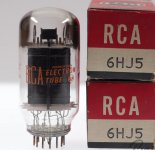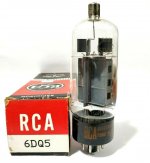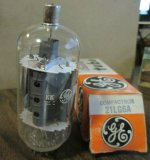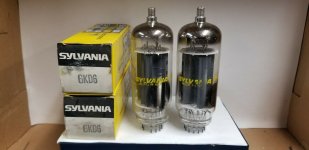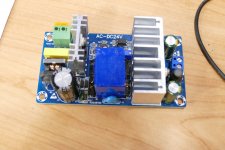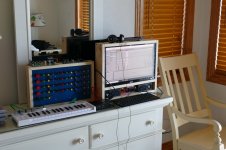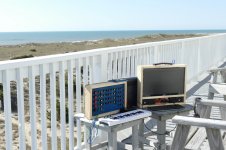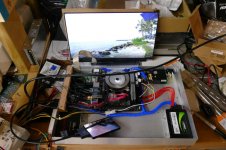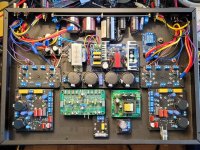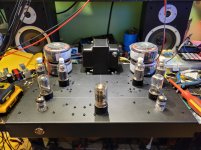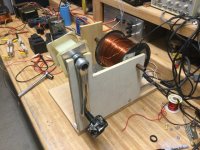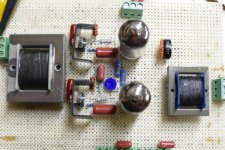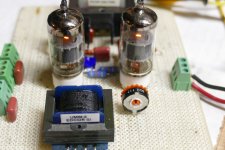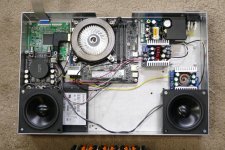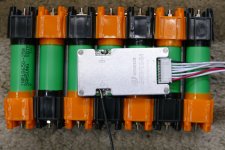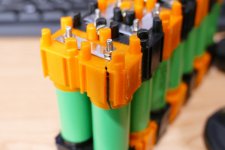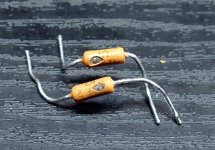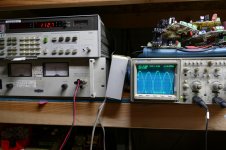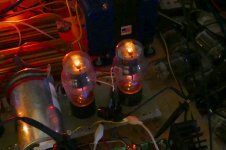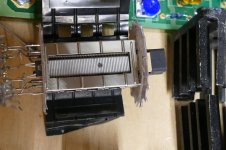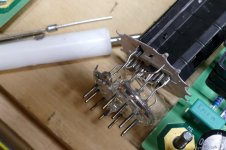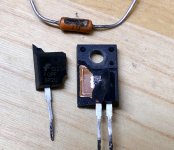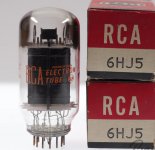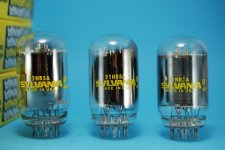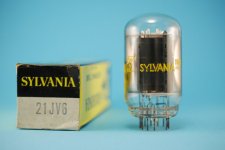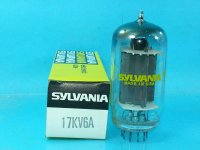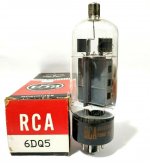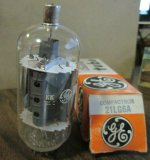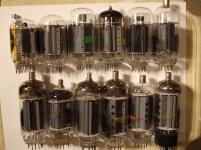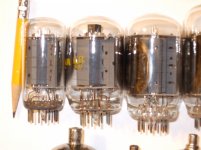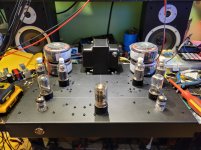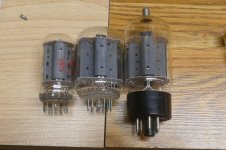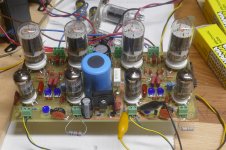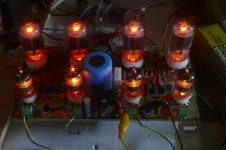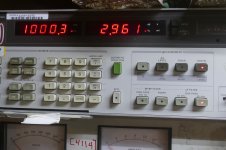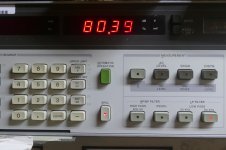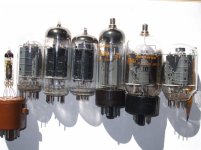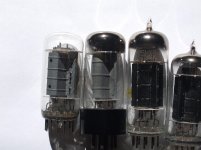21LG6A looks physically similar to the 6HJ5, both being derivatives of 6DQ5.
6KD6 plate size and heater power is noticeably bigger.
With a 1 K Ohm P to P OT at 80 Watts, that would be pushing the peak current rating, so running at low heater V would not be a good idea.
I would increase the OT to more like 2K or 2.5K. George was running the 6HJ5 with a 3.3K OT as I recall, and getting 75 Watts I think.
W = I^2 R
So (OT) R would be expected to vary as 1/ Ipeak squared. (use 2 times Watts and 1/4 P to P Ohms for getting peak AC current, above idle current)
Lower tube plate current will last longer, but requires higher B+ to get the same Watts. (the tube is also more efficient at higher B+ ) Any OT from 4K down should have good bandwidth. Just keep B+ practical and Ip peak within ratings with at least some derating.
Peak current ratings: and heater current (at 6.3V equivalent)
6HJ5 1000 mA, 2.25 A
6DQ5 1100 mA, 2.5 A
6LG6A 1100 mA, 2.0 A
6KD6 1400 mA, 2.85 A
6KD6 plate size and heater power is noticeably bigger.
With a 1 K Ohm P to P OT at 80 Watts, that would be pushing the peak current rating, so running at low heater V would not be a good idea.
I would increase the OT to more like 2K or 2.5K. George was running the 6HJ5 with a 3.3K OT as I recall, and getting 75 Watts I think.
W = I^2 R
So (OT) R would be expected to vary as 1/ Ipeak squared. (use 2 times Watts and 1/4 P to P Ohms for getting peak AC current, above idle current)
Lower tube plate current will last longer, but requires higher B+ to get the same Watts. (the tube is also more efficient at higher B+ ) Any OT from 4K down should have good bandwidth. Just keep B+ practical and Ip peak within ratings with at least some derating.
Peak current ratings: and heater current (at 6.3V equivalent)
6HJ5 1000 mA, 2.25 A
6DQ5 1100 mA, 2.5 A
6LG6A 1100 mA, 2.0 A
6KD6 1400 mA, 2.85 A
Attachments
Last edited:
It would push the peak current, but people don't listen to 80W sine so it'd work alright anyway - agreed though - not a 6KD6, my bad. It looks more like I'd run it like the 6P36S using 80mA idle into 2k2 plate to plate.
FWIW I run 6P31S at 60mA 320V B+ and 2k2 loading, too. They make almost 30W before they run out of negative grid - more if I ran them into AB2.
FWIW I run 6P31S at 60mA 320V B+ and 2k2 loading, too. They make almost 30W before they run out of negative grid - more if I ran them into AB2.
OK, I'm just trying to be sufficiently conservative for a 1st build with 21LG6 tubes. Don't want to see smoke established as their reputation. These tubes should work fine in place of 6HJ5s.
George's specs are usually about as far as one wants to take it. Wouldn't want a 1st build to make bigger flames. (Just kidding.)
21EX6 would be another good sub for 6HJ5. ($3 at Vacuumtubes,net) I see 6HD5 there for $3 too. (not a lot of supply around for 6HD5 however)
George's specs are usually about as far as one wants to take it. Wouldn't want a 1st build to make bigger flames. (Just kidding.)
21EX6 would be another good sub for 6HJ5. ($3 at Vacuumtubes,net) I see 6HD5 there for $3 too. (not a lot of supply around for 6HD5 however)
Last edited:
21LG6A looks physically similar to the 6HJ5, both being derivatives of 6DQ5. 6KD6 plate size and heater power is noticeably bigger.
George was running the 6HJ5 with a 3.3K OT as I recall, and getting 75 Watts I think.
I built a mildly modified version of Pete's Engineer's Amp running 6HJ5's on 600 volts into 3300 ohms. It made 125 WPC. My board was used as a HiFi amp, and as a PA amp for a few outdoor shows for a rock band. I also played my guitar through it a few times. It lived for about 4 years before being packed up to move 1200 miles, and hasn't seen power since. It went though 4 years of "rough service" on the same set of tubes with no issues.
I published the details somewhere in the original Engineers Amp thread and at least 10 copies were built. If there were any failures, they were not mentioned in the thread.
Pete made a monoblock version with a more conservative 50 watt power level using the same 6HJ5 / 6GU5 tube lineup. It would do well with 21LG6's at power levels to at least 100 WPC.
The 19.5 volt power brick is probably OK it it will start up into the load provided by a few cold tubes. I'm assuming a stereo amp, that means 4 tubes. The initial start current is probably over 10 amps for a second or so. Some SMPS's will just fail to start, some will enter "hiccup mode" and then may or may not recover. The only way to know is to try it. I need to use a 150 watt Meanwell SMPS to light 4 X 36LW6's. The 100 watt version will not turn on every time.
Have you ever used a cheap one George?
I used to use one of these to light up 4 36LW6. A bad connection caused a red plate on one of them and I haven't used them since - cheaper to use Soviet tubes
https://www.amazon.ca/AC-DC-100-240V-Supply-Switching-Module/dp/B082G7ZKXG/
I used to use one of these to light up 4 36LW6. A bad connection caused a red plate on one of them and I haven't used them since - cheaper to use Soviet tubes
https://www.amazon.ca/AC-DC-100-240V-Supply-Switching-Module/dp/B082G7ZKXG/
The 19.5 volt power brick is probably OK it it will start up into the load provided by a few cold tubes. I'm assuming a stereo amp, that means 4 tubes. The initial start current is probably over 10 amps for a second or so. Some SMPS's will just fail to start, some will enter "hiccup mode" and then may or may not recover. The only way to know is to try it. I need to use a 150 watt Meanwell SMPS to light 4 X 36LW6's. The 100 watt version will not turn on every time.
Thanks, I will most likely build one channel just to play and experiment with and drive it with my bass guitar. When I go stereo I will probably get a proper supply for the heaters.
Have you ever used a cheap one George?
I used to use one of these to light up 4 36LW6.
I got one like it except it's for 24 volts. I used in a portable computer I built for a stand alone musical instrument (several software synthesizers, drums and a DAW). I turned the 24 volt board up to 27 volts. It powered the charging system for 8 X 26650 LiFePo4 cells and fed a buck converter that made 12 volts for the Core I7-8700 motherboard. That little power supply got rather hot when the batteries were charging and the motherboard was doing something that sucked serious power.
This was for my second attempt at making a portable Music Computer. As with the first one, there were still some issues, mostly with ergonomics, and the fact that I'm learning how to use all of this stuff as I go along, so #1 sits under the desk unused, and #2 was never completely finished, and has been disassembled, and is undergoing a rethink, and redesign. #1 was mostly vertical. #2 was like a big wooden laptop with a computer keyboard and a piano style keyboard, but it was too big, heavy and got too hot to actually use on my lap for long.
#3 will use 14 x 18650 Lithium Ion cells which have powered the motherboard for over 2 hours while it was running Prime 95 on all cores simultaneously. I got a better quality 28 volt 200 watt power supply that I will use to power it all. It will self limit the current to avoid overheating if the CPU is cranking while the batteries are charging. This will just slow the charge time.
These pictures show Music Computer #1 on vacation in the outer banks of North Carolina overlooking the Atlantic Ocean. Here issue #1 became obvious. You can't see that screen in even reflected sunlight. Works fine in the room.
#2 never made a road trip due to Covid. It would have gone to Florida with me in July, but that trip didn't happen. It got some use in local parks, but after I lugged it up to the top of a 600 foot hill overlooking the Ohio river only to find the display cracked, I lost my patience with it and it ceased to exist. This picture shows it after I swapped the blue Amazon 24 volt supply for the black Mouser sourced "medical grade" supply. I was in the process of swapping out the 8 26650 cells for a 14 cell pack made with 18650's when I took this picture. I didn't want to risk an expensive motherboard / CPU or some possibly unstable batteries on a cheap supply. The 4K display is seen in the background. It is broken and no longer available on Ebay.
#3 will not use a 4K screen since they are hard to find and didn't offer any improvement with the software I was using. It may have two screens, and maybe two CPU's If I can make it all work out on the bench BEFORE making any cabinet parts.....maybe next July.
Attachments
Last edited:
21LG6A looks physically similar to the 6HJ5, both being derivatives of 6DQ5.
6KD6 plate size and heater power is noticeably bigger.
Been wondering which of those to use first - the 21LG6 or 26DQ5. Got some of each, and a 1650T OPT. Looking to make 120-150 watts for a bass. Don’t need more power - the old vintage 18” Pyle driver wouldn’t handle it anyway. I’ve got to start winding the power trafo this week and need to finalize the winding plan. Maybe I ought to have both 21 and 26 volt heater taps? (12 at a couple amps for everything else.) The LG6’s are rated a little higher - would it be better to save them for something “bigger”?
The original plan was to use 6CB5’s, but I only have 4 and am having trouble getting any *more*. That would make a retube difficult.
I’ve got to get busy winding. Busy, busy, busy......
Attachments
I spent most of today ripping apart and rebuilding a prototype Voltage Controlled Amplifier that I built about a year ago. I got some new transformers to try, and the original board had 5 tube sockets so I could try everything from old radio tubes 6BE6, 6BA6, 6AS6... to TV tubes. After deciding on a bunch of different TV tubes, all with compatible pinouts, 5 sockets became 2, and a whole bunch of unused circuitry vanished. All the issues identified in the last proto are gone. The pictures show a pair of 6KT6's offering 96 dB of gain control range, with THD in the 0.5% range at 25 volts RMS of output. Lower 3db point is now 14 Hz where the THD rises to 0.9%. The upper 3dB point is somewhere beyond 30 KHz. All measurements were done in pentode mode, with a fat resistor in series with the screens. Tomorrow I may try triode mode.
While digging for parts I got the box containing the remains of the Music Computer I mentioned in post #1327 off the shelf. The motherboard has been changed to the mentioned Core I7-8700 unit, the power supply with the black heat sink is the medical grade unit that makes 28.5 volts from 120 VAC. It feeds the two blue boards, one makes 12 volts to run the display driver board, The other makes 19 volts to run the motherboard and the class D audio amp. The battery control perf board is missing due to a dead relay.
The lithium battery pack and BMS is also not installed. I tried several different holders for the 18650 cells before settling on these plastic thingies that I ordered from India. After waiting forever to get them they seemed perfect....until the orange pieces started splitting. No black parts failed, but the orange ones have cracked while sitting in my basement unused. I took the pack out of the chassis to avoid a bad situation if one cracked far enough to allow a short.
While digging for parts I got the box containing the remains of the Music Computer I mentioned in post #1327 off the shelf. The motherboard has been changed to the mentioned Core I7-8700 unit, the power supply with the black heat sink is the medical grade unit that makes 28.5 volts from 120 VAC. It feeds the two blue boards, one makes 12 volts to run the display driver board, The other makes 19 volts to run the motherboard and the class D audio amp. The battery control perf board is missing due to a dead relay.
The lithium battery pack and BMS is also not installed. I tried several different holders for the 18650 cells before settling on these plastic thingies that I ordered from India. After waiting forever to get them they seemed perfect....until the orange pieces started splitting. No black parts failed, but the orange ones have cracked while sitting in my basement unused. I took the pack out of the chassis to avoid a bad situation if one cracked far enough to allow a short.
Attachments
Been wondering which of those to use first - the 21LG6 or 26DQ5. Got some of each, and a 1650T OPT.
The two tubes are pretty near the same, the 21LG6 specs at lower screen current and so can run more plate power with the reduced screen power.
I once saw an amplifier schematic in Glass Audio "The Snubber" amplifier by David Wolze (Glass Audio 3/ 1995, pages 18 and 19) which uses the Hammond 1650T OT with 42KN6 tubes to make 120 Watts. (these have a 1500 mA peak rating, similar to 6KD6) It is likely designed to stay strictly within the tube ratings.
George's Watt #'s typically push the Sweep tube ratings some, which is alright as long as you don't plan to run a continuous sine wave at full power. (audio signals having a statistical power distribution that averages notably lower than max power by some 'crest factor" ) Can often "stretch" TV Sweep tube Watt ratings by 30% for audio use. But good to stay within the max current rating for tube longevity.
https://www.diyaudio.com/forums/tubes-valves/109534-please-help-build-amp-father-3.html#post1329882
Last edited:
They’d stay within ratings if I use 4 of them. Could keep g2 at 120 and supposedly have enough current capability. I kind of had a vision of a 4-tuber, anyway.
When I did go looking for KN6’s I came up empty. I do have one lone pair of 36LW6 (the bulk of them I have are 26’s) that I *could* use, but they might make a good future UNSET. Cheaper than real 300B’s. Way too many potential projects.
When I did go looking for KN6’s I came up empty. I do have one lone pair of 36LW6 (the bulk of them I have are 26’s) that I *could* use, but they might make a good future UNSET. Cheaper than real 300B’s. Way too many potential projects.
George's Watt #'s typically push the Sweep tube ratings some, which is alright as long as you don't plan to run a continuous sine wave at full power. (audio signals having a statistical power distribution that averages notably lower than max power by some 'crest factor" ) Can often "stretch" TV Sweep tube Watt ratings by 30% for audio use. But good to stay within the max current rating for tube longevity.
The limiting factor in the 125 WPC into 3300 ohms 6HJ5 amp was idle power dissipation. My B+ was 620 to 640 volts at idle, and I needed about 30 mA per tube to get the 1 watt THD into the 0.2% range (no GNFB). B+ dropped to about 600 volts at full power. The amp actually cooled off when driven to clipping with typical rock music. Max dissipation was with a continuous sine wave of 80 to 90 watts, but you won't do that long with speakers hooked up.
With the possible exception of some of today's uber-compressed pop noise, most music has at least 10 dB of crest factor, meaning that the average music POWER is at least 10dB lower than the peaks. So for that 125 watt amp touching clipping on peaks, the average power output is 12.5 watts.
Four things kill tubes, average plate dissipation, average screen dissipation, average cathode current, and peak cathode current. All must be respected.
The plate in any output tube is quite large and has considerable thermal mass. The "average" time period is in seconds, so a short peak well in excess of the ratings can be absorbed if followed by a cooling period such that the average is in spec. The horizontal output tube in a TV set gets no break. It runs at full power all the time, so the ratings are a bit conservative. Compare the plate in a 40 watt 36LW6 with the 40 or 42 watt plate in a KT88 or 6550. If the 36LW6 was a typical audio tube it would have a 50 or 60 watt rating.
The screen grid is made of tiny wires. They can be melted in far less than a second, and completely vaporized instantly if overloaded bad enough. The averaging time here is milliseconds. TV sweep tubes have a rather low screen voltage rating. Respect it with some margin and you will be OK.
Too much constant cathode current raises the cathode temperature and causes early failure. Anything below the average current rating is usually OK, and for audio amp use where the B+ is relatively constant, not even an issue.
The true peak cathode current spec will vary from tube to tube due to manufacturing tolerances. No tube is perfectly aligned, so some areas on the cathode and plate will see more current than others. Too much cathode current in a small localized area will invoke a tube arc, a literal ionized lightning bolt from cathode to plate. If there is nothing to limit the current the tube can explode. I have done it twice, and shattered a third. If the current is below the threshold for "rapid decomposition" a chunk of the cathode coating will be ripped off and the tube may recover with a slight loss of performance.
I decided to see how much power I could squeeze out of two pair of old 6L6GA's in a breadboarded stereo amp. I had achieved 110 watts per channel of continuous sine wave, but attempting to go further caused an arc that blew holes in the 1 ohm 1 watt cathode resistor. This indicates an arc current well in excess of 1 amp. I replaced the resistor, and cranked up again, eventually blowing a resistor in the other channel. New resistor, try again, amp still plays fine at 100 WPC. I left it at that level and listened to it for a couple days before moving on to different tubes.
The tube arc that caused a 6HJ5 to explode also blew up the driver mosfet, and cathode resistor. This arc was fed by an ancient HP 60Hz SMPS that has 1000 uF of output capacitance. It was turned up to 650 volts capable of delivering over 200 Joules of energy. Hundreds of amps flowed through the tube and it's plate pin. The pin was welded into the tube socket and the wire through the glass vaporized causing the tube to violently shatter. Autopsy revealed a spot on the cathode where the coating was gone. Other than the shattered glass, no other obvious damage.
The 6L6GA's can be seen cranking out 112 watts. Nothing is glowing in this picture that has been lightened up to see any possible glowing parts. The two dead cathode resistors reveal a large current pulse.
Your OPT's are 1.9K ohms. My experiments with 36LW6's show that maximum efficiency is achieved somewhere around 2500 ohms, but I was aiming for 250 watts per pair.
You stated that you want 120 to 150 watts for "a bass." I'm assuming this means a bass guitar. If so, and you are the kind of player that creates a lot of dynamic transients, you will see situations where the playing may attempt to instantly reverse the movement of the speaker cone resulting in a lower dynamic impedance that the speaker's rated impedance. Combined with your 1.9K ohm OPT.....I would use 4 tubes if I was building it.
The other tube that I exploded was in a guitar amp that I had built over 20 years ago. Nothing special, 2 X KT88's or 6550's on about 430 volts for about 50 watts. It had been working fine for a couple years with Sovtek 6550WA's in it. I got a big box full of new Chinese KT88's real cheap from Stan at ESRC when he decided that he couldn't sell them due to poor reliability. I put a pair in my amp and played it for a while. I was wailing away at full crank when a loud zap came from the speaker and a POP came from the amp. One KT88 had shattered and the line fuse had blown. The amp chassis was sitting on the bench, so minimal vibration was involved.
I went through that box of over 100 tubes, and kept about 10. I still have a few and they work fine at over 100 watts per pair....the rest remind you that the Chinese invented fireworks. Their tubes have improved a lot in the 20 years since though.
Attachments
With paralleled up tubes, you could drop back to a smaller tube to go plate cap-less.
17/22KV6A, 22JR6, 22JG6 all have 950 mA peak ratings and 22W, 17W, 17W plate ratings. (the --KV6 28W rating on the datasheet is for regulator service where screen dissipation is kept low)
These are usually available for reasonable $. However, all of these use 9 pin NOVAR sockets, which are hard to find the "real" NOVAR sockets for. Many Chinese sockets are listed as Magnoval/Novar, but Novar tubes will fall out of them. (Magnoval tube pins are bigger).
Then there are 21HB5A and 21JV6 which are a 12 pin Compactron. 18W and 800 mA peak rated. Usually reasonable $ too. (used to be on the $1 lists at Vacuumtubes.net and ESRC)
If you don't mind the plate caps, then the bigger 6HJ5, 6DQ5, 21LG6A paralleled up are probably best for "over 10" musical instrument Bass amplifier use.
17/22KV6A, 22JR6, 22JG6 all have 950 mA peak ratings and 22W, 17W, 17W plate ratings. (the --KV6 28W rating on the datasheet is for regulator service where screen dissipation is kept low)
These are usually available for reasonable $. However, all of these use 9 pin NOVAR sockets, which are hard to find the "real" NOVAR sockets for. Many Chinese sockets are listed as Magnoval/Novar, but Novar tubes will fall out of them. (Magnoval tube pins are bigger).
Then there are 21HB5A and 21JV6 which are a 12 pin Compactron. 18W and 800 mA peak rated. Usually reasonable $ too. (used to be on the $1 lists at Vacuumtubes.net and ESRC)
If you don't mind the plate caps, then the bigger 6HJ5, 6DQ5, 21LG6A paralleled up are probably best for "over 10" musical instrument Bass amplifier use.
Attachments
Last edited:
Those 21HJ5’s just look “stubby” to me  . I think the HB5’s are like $3 now. The socket costs more than that. I’ve got plenty of plate caps - they kind of look “menacing”. A Franken-amp with some Abbey Normal tubes..... just what this crackpot ordered.
. I think the HB5’s are like $3 now. The socket costs more than that. I’ve got plenty of plate caps - they kind of look “menacing”. A Franken-amp with some Abbey Normal tubes..... just what this crackpot ordered.
I bought some of the magnoval sockets from tube depot, and the 6LR8’s I’ve got seem to fit them just fine. Good enough to try making a little 25 watt per channel integrated. If I lose a g1 connection and it red plates the damage couldn’t be too extensive.
I bought some of the magnoval sockets from tube depot, and the 6LR8’s I’ve got seem to fit them just fine. Good enough to try making a little 25 watt per channel integrated. If I lose a g1 connection and it red plates the damage couldn’t be too extensive.
The two tubes are pretty near the same, the 21LG6 specs at lower screen current and so can run more plate power with the reduced screen power.
I once saw an amplifier schematic in Glass Audio "The Snubber" amplifier by David Wolze (Glass Audio 3/ 1995, pages 18 and 19) which uses the Hammond 1650T OT with 42KN6 tubes to make 120 Watts. (these have a 1500 mA peak rating, similar to 6KD6) It is likely designed to stay strictly within the tube ratings.
George's Watt #'s typically push the Sweep tube ratings some, which is alright as long as you don't plan to run a continuous sine wave at full power. (audio signals having a statistical power distribution that averages notably lower than max power by some 'crest factor" ) Can often "stretch" TV Sweep tube Watt ratings by 30% for audio use. But good to stay within the max current rating for tube longevity.
https://www.diyaudio.com/forums/tubes-valves/109534-please-help-build-amp-father-3.html#post1329882
Is Wolze still around? I’d love to see some more details on his design like bandwidth. Was it intended to be hifi or guitar? I located the schematic with a little help. I’m planning to use a dynaco A431 with a 4ohm load on the 8ohm tap to produce a 2150ohm reflective load. Very glad I stumbled on your post. I was already intending on using the 6KN6.
Those 21HJ5’s just look “stubby” to me
Well, there are some 21HB5A tubes with a grid 1 cooler that are taller, but not common. 6GE5/6JN6 are stubby for sure, some call them "cute".
Top row L to R: 6GE5/6JN6, usual 21HB5A, tall 21HB5A, 17KV6A, 6HJ5, 21LG6A
note that 21HB5A has the same size plate as the 17KV6A, 6HJ5 and 21LG6A
Bottom row: 35LR6, 42KN6 (old type), 42KN6 (new type = 6KD6), 36MC6, 26LX6, 36LW6
I like the 17KV6A with the seal tip on top for looks. They look antique. (not all --KV6 have the tip on top, mostly Sylvania 17KV6A have that)
And then there is the 6GF5 (left side, 2nd pic) "cute" or "runt"? 9 Watt TV Sweep. A good HV driver for screen grid drive.
6GE5/6JN6 to right of it, then 21HB5A.
Attachments
Last edited:
And then there is the 6GF5 (left side, 2nd pic) "cute" or "runt"? 9 Watt TV Sweep. A good HV driver for screen grid drive.
Those little "runts" come from a line of sweep tubes that dates back to my pre-teens pulling tubes out of dead TV sets. The picture shows a 6GF5, a 6GE5, and a 6DQ6. All have exactly the same guts except that the plate fins on the 6GF5 have been clipped to make them fit inside the "cute" little bottle. I have found 3 different varieties of them differing only in height.
I have previously extracted over 100 watts per pair from both of the two big brothers, so I made a little push pull board using the CED technology to beat on the little guys. Those little "driver" tubes drove the power meter past 80 watts at 3% THD per channel and kept it there for 10 minutes. What looks like a red stripe on one or two plates was not visible to the eye in a room only lit by the amp, and some pilot lights.
Attachments
Lilliputian up through "cute"
5902 4.1 W ( also 5987 at 4 W, 5639 at 3.8 W and 5640 at 3.5 W )
6GF5 9 W
25HX5 14 W
7754 16W
EL36/6CM5/6P31S 12+ W
6G-B7 15 W
12GE5/6JN6 17 W
Wonder what George can do with that 5902 with some LN2 cooling? Probably burn the wires off.
Oh yeah, I forgot 6AV5GT / 6BQ6 at 11 W. The 6AV5GT looks similar to the 6GF5. (2nd pic: 6GF5 on left, 6AV5GT 2nd from left, 25HX5 3rd, 7754 on Rt. )
5902 4.1 W ( also 5987 at 4 W, 5639 at 3.8 W and 5640 at 3.5 W )
6GF5 9 W
25HX5 14 W
7754 16W
EL36/6CM5/6P31S 12+ W
6G-B7 15 W
12GE5/6JN6 17 W
Wonder what George can do with that 5902 with some LN2 cooling? Probably burn the wires off.
Oh yeah, I forgot 6AV5GT / 6BQ6 at 11 W. The 6AV5GT looks similar to the 6GF5. (2nd pic: 6GF5 on left, 6AV5GT 2nd from left, 25HX5 3rd, 7754 on Rt. )
Attachments
Last edited:
- Home
- Amplifiers
- Tubes / Valves
- Those Magnificent Television Tubes
